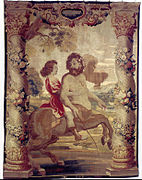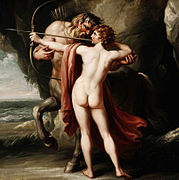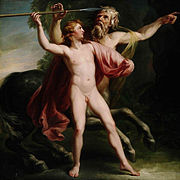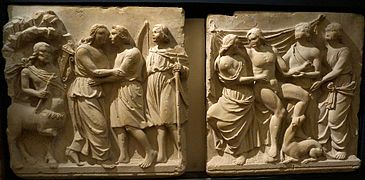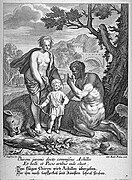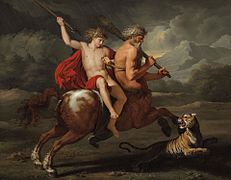Chiron
| Chiron | |
|---|---|
 The Education ofAchillesby Chiron,frescofromHerculaneum,1st century AD (Museo Archeologico Nazionale, Naples) | |
| Abode | Thessaly |
| Genealogy | |
| Parents | CronusandPhilyra |
| Siblings | Hestia,Demeter,Hera,Hades,Poseidon,Zeus |
| Consort | Chariclo |
| Children | Hippe,Endeïs,Ocyrhoe,Carystus,Aristaeus |
InGreek mythology,Chiron(/ˈkaɪrən/KY-rən;alsoCheironorKheiron;Ancient Greek:Χείρων,romanized:Kheírōn,lit. 'hand')[1]was held to be the superlativecentauramongst his brethren since he was called the "wisest and justest of all the centaurs".[2]
Biography[edit]

Chiron was notable throughout Greek mythology for his youth-nurturing nature. His personal skills tend to match those of his foster fatherApollo,who taught the young centaur the art of medicine, herbs, music, archery, hunting, gymnastics, and prophecy, and made him rise above his beastly nature.[3]Chiron was known for his knowledge and skill with medicine, and thus was credited with the discovery of botany and pharmacy, the science of herbs and medicine.[4]
Likesatyrs,centaurs were notorious for being wild, lusty, overly indulgent drinkers and carousers, violent when intoxicated, and generally uncultured delinquents. Chiron, by contrast, was intelligent, civilized, and kind, because he was not related directly to the other centaurs[5]due to his parentage. He was the son of the TitanCronusand theOceanidPhilyra,[6]and thus possible brother toDolops[7]andAphrus,the ancestor andeponymof the Aphroi, i.e. the nativeAfricans.[8][9]Chiron lived predominantly onMount Pelion;there he married thenymphChariclowho bore him three daughters,Hippe(also known asMelanippemeaning the "black mare" orEuippe,"good mare" ),Endeïs,andOcyrhoe,and one sonCarystus.A different source also stated that his wife was calledNais[citation needed]while a certain Aristaeus was called his son.[10]
Like the other centaurs, Chiron was later expelled by theLapithaefrom his home; but sacrifices were offered to him there by theMagnesiansuntil a very late period, and the family of the Cheironidae in that neighbourhood, who were distinguished for their knowledge of medicine, were regarded as his descendants.[11]
Physical appearance[edit]

Although acentaur,Chiron's physical appearance often differs somewhat from other centaurs, demonstrating his status and heritage. In traditional Greek representations of Chiron his front legs are human, rather than equine. This is in contrast to the traditional representation of centaurs, which have the entire lower body of a horse.[12]This clearly sets Chiron apart from the other centaurs, making him easily identifiable. This difference may also have highlighted Chiron's unique lineage, being the son ofCronus.Chiron is often depicted carrying a branch with dead hares he has caught hanging from it. Chiron is also often depicted wearing clothes, demonstrating he is more civilised and unlike a normal centaur (the only other occasional exceptions to this rule are the centaursNessusandPholus).
TheEducation ofAchilleswall painting, from the basilica in Herculaneum (top right), is one of the most common Roman depictions of Chiron, as he teaches Achilles the lyre. In this version we see Chiron with a fully equine lower body, in contrast to the ancient Greek representations. In addition to this reconfiguration, Chiron's appearance is further altered with his ears. Whereas previously human, Chiron's ears now match those of asatyr;folded over at the top. This rendering creates a more bestial version of Chiron, much more akin to a standard centaur. It may be possible that due to the rise of written sources, Roman artists were inspired by written descriptions of Chiron; simply using the word centaur, rather than having available traditional visual representations. This may, then, not be a deliberate reworking of the Chiron myth on the part of the Romans, but simply a lost nuance of the character in its migration from Greece to Rome. As F. Kelsey writes;"The Chiron of our painting,... has a body like that of the other centaurs, but the prominence of the human element in his nature is no less marked; he is the wise and gentle teacher, the instructor of an art".[13]Chiron has retained an element of clothing and gained a laurel wreath, suggesting the artist wished to portray nobility, or even divinity, more consistent with the traditional view. It has also been suggested that this fresco is a reproduction of an actual statue in the Roman forum.
Mythology[edit]
Early years[edit]

According to an archaic myth,[14]Chiron was sired by theTitanCronuswhen he had taken the form of ahorse[15]and impregnated thenymphPhilyra.[16]In another version his mother was the nymphNaïs.[17]
Chiron's lineage was different from other centaurs, who were born fromIxion,consigned to a fiery wheel, andNephele( "cloud" ), which in the Olympian tellingZeusinvented to look likeHera.
Soon after giving birth to Chiron, Philyra abandoned her child out of shame and disgust. Chiron, effectively orphaned, was later found by the godApollo,who took him under his wing and taught him the art of music, lyre, archery, medicine and prophecy. Apollo's twin sister, Artemis, trained him in archery and hunting. Chiron's uniquely peaceful character, kindness, and intelligence are attributed toApolloandArtemis.
Some sources speculate that Chiron was originally aThessaliangod, later subsumed into theGreekpantheon as a centaur.[citation needed]
A great healer,astrologer,and respected oracle, Chiron was said to be the first among centaurs and highly revered as a teacher and tutor. Among his pupils were manyculture heroes:Asclepius,[18][19][20]Aristaeus,[21]Actaeon,[22]Achilles,[23][24]Jason,[25][26]Medus.[27][28]
There is also a persistent link withPeleusthroughout Chiron's myth. This can be explained that the latter was the grandfather of Peleus through his daughter Endeis who married the king of Aegina, Aeacus. Chiron saved the life ofPeleuswhenAcastustried to kill him by taking his sword and leaving him out in the woods to be slaughtered by the centaurs. Chiron retrieved the sword for Peleus.[29]Chiron then explained to Peleus how to capture the nymphThetis,leading to their marriage.
Chiron is also connected with the story of theArgonauts,whom he received kindly when they came to his residence on their voyage, for many of the heroes were his friends and pupils.[30]
Students[edit]

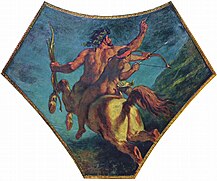
Chiron was a renowned mentor, and brought up some futureheroessuch as:
- Achilles– The son of theArgonautPeleus and theNereidThetis.Peleus had a friendly relationship with Chiron who had already saved him from Acastus and a band of murderous centaurs,[29]and later restored the sight ofPhoenix,a blind friend of Peleus.[31]When Achilles was old enough, Peleus brought him to Chiron, who received him as a disciple, and fed him the innards of lions and boars, and bear marrow. In some accounts, Achilles was previously called "Ligyron", and Chiron gave him his new name.[23][24]Later in his life, Achilles taughtPatrocluswhat Chiron had taught him, including the medical arts.[24]
- Aristaeus– Although his motherCyrenelived inLibya,Aristaeus' fatherApollobrought him on Mount Pelion to be reared by Chiron. Aristaeus would later become in his life a god of certain rustic arts such asbeekeepingandcheesemaking.Moreover, he is the protagonist of a creation myth regarding theEtesian winds.[21]
- Actaeon– The son ofAutonoëand Aristeus (an aforementioned student of Chiron). He became an excellent hunter thanks to the centaur's lessons. In his adulthood as he was hunting in the woods, he saw the virgin goddessArtemisbathing. She punished Actaeon for seeing her naked body by turning him into astag.Hishunting dogsdid not recognize him and devoured him. Ignorant of what they had done, the hunting dogs came to the cave of Chiron seeking their master and the Centaur fashioned an image of Actaeon in order to soothe their grief.[22]
- Asclepius– The Greek God of Doctors.Artemiskilled Asclepius' motherCoronisafter her loverApollodiscovered she was cheating on him. But Coronis had conceived a son to him and before her body had been consumed by the funerary pyre he saved the child (Asclepius) and brought him to Chiron, who reared him and taught him the art of healing. When Chiron's daughterOcyrhoesaw him, she prophesied his destiny and death. Because of this,Zeusturned her into a mare. In fact, Asclepius would later die because of hishubris:he had become such a skilled medic he could resurrect the dead and Zeus would end up killing him for this after getting a complaint fromHades.Though Zeus would later revive him as a God to avoid any feuds with Apollo.[20][18][19]
- Jason– The leader of theArgonautswas, in some versions, raised by Chiron. Jason's fatherAesonhad been locked up by his brotherPelias,yet he managed to conceive a son with a woman namedAlcimede.When Alcimede delivered Jason, she pretended he was a stillborn to escape Pelias' notice and then gave him to Chiron. Jason's son Medus will also become one of the centaur's students.[25][26]
- Medus– Alternatively called Medeus or Polyxenus, his mother wasMedea,but accounts differ about his father, who may be eitherJason,an Asian king, orAegeus of Athens.[28]Just like his father, he was reared by Chiron.[27]Later in his life, he would become the first king of theMedes.
- Patroclus[32]is also numbered amongst the students byStatius(a roman poet of the 1st century AD) in his unfinished work, the Achilleid, although Homer clearly contradicts him.[24]
According to Ptolemy Hephaestion (probably the same asPtolemaeus Chennus), a writer and playwright whose works are now lost, Chiron was also the mentor of the godDionysus(who became the centaur'seromenos,and learned from him chants and dances) and of a youth named Cocytus; the latter supposedly curedAdoniswhen he was wounded by awild boarusing the medical techniques learned from his teacher.[33]It is worthy of note that Ptolemy's account only survived thanks toPhotios I's summary of his works. Photios I, an ecumenical patriarch of the 9th century AD, harshly criticized Ptolemy, denouncing him for seemingly distorting, inventing and misinterpreting myths.[33]Considering little is known about Ptolemy and his works are not preserved, it is unknown whether he was simply reporting alternative versions of myths or making them up.
Death[edit]

His nobility is further reflected in the story of his death, asPrometheussacrificed his life, allowing mankind to obtain the use of fire. As the son of Cronus he was immortal, so it was left to Heracles to arrange a bargain withZeusto exchange Chiron's immortality for the life of Prometheus who had been chained to a rock where an eagle pecked out his regenerating liver for his transgressions.[34]Chiron was pierced with an arrow belonging to Heracles that had been treated with the blood of theHydra,or, in other versions, poison that Chiron had given to the hero when he had been under the honorable centaur's tutelage. According to aScholiumonTheocritus,[35]this had taken place during the visit of Heracles to the cave ofPholuson MountPelioninThessalyduring his fourth labour, defeating theErymanthian Boar.While they were at supper, Heracles asked for some wine to accompany his meal. Pholus, who ate his food raw, was taken aback. He had been given a vessel of sacred wine byDionysussometime earlier, to be kept in trust by the centaurs until the right time for its opening. At Heracles' prompting, Pholus was forced to produce the vessel of sacred wine. The hero, gasping for wine, grabbed it from him and forced it open. Thereupon the vapors of the sacred wine wafted out of the cave and intoxicated the wild centaurs led byNessuswho had gathered outside. They attacked with stones and fir trees the cave which was located in the neighbourhood ofMalea.Heracles was forced to shoot many arrows (poisoned with the blood of theHydra) to drive them back. During the assault, Chiron was hit in the thigh by one of the poisoned arrows. After the centaurs had fled, Pholus emerged from the cave to observe the destruction. Being of a philosophical frame of mind, he pulled one of the arrows from the body of a dead centaur and wondered how such a little thing as an arrow could have caused so much death and destruction. In that instant, he let slip the arrow from his hand and it dropped and hit him in the hoof, killing him instantly. This, however, is open to controversy, because Pholus shared the "civilized centaur" form with Chiron in some art images, and thus would have been immortal.
Ironically, Chiron, the master of the healing arts, could not heal himself and willingly gave up his immortality. For this reason, his half-brother Zeus took pity on him and thus placed him among the stars in the sky to be honored. The Greeks identified him as theconstellationCentaurus.[36]
InOvid's poemFasti,Ovid has the heroHerculesvisiting Chiron's home on Pelion while the childAchillesis there.[37]While Chiron is examining Hercules' weapons, one of the arrows dipped inLernaean hydravenom falls on Chiron's left foot and poisons him:
- And while the old man fingered the shafts clotted with poison, one of the arrows fell out of the quiver and stuck in his left foot. Chiron groaned and drew the steel from his body.[38]
Chiron then tries to use herbs to heal himself, but fails. After nine days with a weepingAchilleslooking on, Chiron passes into the stars becoming a constellation.[39]
ThePrecepts of Chiron[edit]

Adidactic poem,Precepts of Chiron,has been lost. However, fragments in heroichexametersthat survive in quotations are considered to belong to it.[40]The common thread in the fragments, which may reflect in some degree the Acharnian image of Chiron and his teaching, is that it is expository rather than narrative, and suggests that, rather than recounting the inspiring events of archaic times as men likeNestor[41]orGlaucus[42]might do, Chiron taught the primeval ways of mankind, the gods and nature, beginning with the caution "First, whenever you come to your house, offer good sacrifices to the eternal gods".
Statius'Achilleid[edit]
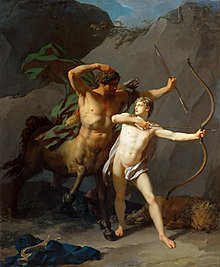
TheAchilleidwas to be an epic poem on the life ofAchilles.However, its author,Statius,died during the writing of the second book late in the first century AD during the reign of the EmperorDomitian.The Achilleidshows the relationship between Chiron and his charge, Achilles. During Book One, the close relationship between Chiron and Achilles is made clear whenThetisspends the evening with them in Chiron's cave on MountPelion,before leaving with Achilles. Chiron is shown in a paternal capacity, rather than that of merely a teacher, and is depicted as far from animal.
Night draws to slumber. The huge Centaur collapses on stone and Achilles fondly twines himself about his shoulders, though his mother is there, preferring the familiar bosom.(1.195–97).
Here, Statius is showing a loving relationship between the two characters, which the traditional view of Chiron never explored. Later, when describing what he ate when growing up, Achilles refers to Chiron as a parent;"thus that father of mine used to feed me" (2.102), the Latin used here is 'pater' so we may judge this an accurate translation. This further demonstrates the nature of the loving relationship between Chiron and Achilles. Statius here may be continuing a theme started byOvidinFastiseveral years earlier.
InFasti,on Chiron's death, Achilles says"'Live, I beg you; don't leave me, dear father [pater]!'" (5.412), this would suggest that in Rome the reconfiguration of Chiron's myth was as a loving and loved foster parent, rather than simply teacher. Chiron's relationship with his pupil is used to demonstrate a Roman longing for the father-son relationship.
In addition to Chiron's loving characteristics developed in Book One, Book Two ofThe Achilleidhas Achilles describe many tasks Chiron would make him perform during his heroic education, including standing in fast flowing rivers;
I stood, but the angry river and the mist of his broad rush took me back. He bore down on me with savage threats and scolded to shame me. I did not leave till ordered (2.146–150).
There is a clear contrast here in the hardship and insults Chiron is directing at his pupil compared to his previous kindness. However, this duality can be seen as a demonstration of a traditionalRoman education,especially a noble one; learning both military and refined arts. Centaurs in antiquity were often remembered for their battle with theLapiths.Statius deliberately disassociates Chiron from this story with his description of Chiron's cave on Pelion,
Here are no darts that have tasted human blood, no ash trees fractured in festive combats, nor mi xing bowls shattered upon kindred foes (1.111–15).
Instead of combat, the emphasis is that Chiron's weapons are only used for hunting and there are no signs of savage behaviour. In addition to Achilles' descriptions of the physical lessons Chiron gives him he also refers to a more cultured education,
He fixed in my mind the precepts of sacred justice (2.163–4).
Statius creates an image of Chiron that is not only a loving father, but a strict and wise teacher, disassociated with the bestial aspects of centaurs.
Gallery[edit]
See also[edit]
- Chyron, a synonym forlower thirdtelevision graphics
- Chyron Corporation,named in reference to Chiron
- 2060 Chiron,a small Solar System body named after Chiron
References[edit]
Citations[edit]
- ^Compare theDactyls,"fingers", ancient masters of the art of metallurgy and magical healers.
- ^Homer,Iliad11.831
- ^Xenophon,Cynegeticus1;Philostratus the Athenian,Heroicus9,Icon.2.2;Pindar,Pythian Odes9.65
- ^Pliny the Elder,Naturalis Historia7.56.3
- ^Homer,Iliad11.831
- ^ScholiaonApollonius Rhodius,Argonautica2.1235 citingPherecydes;Pliny the Elder,Naturalis Historia7.56.3;Hyginus,DeAstronomica2.38.1 ff.
- ^Hyginus,FabulaePreface
- ^Suida,Suda Encyclopedias.v.Aphroi
- ^Fordyce, C. J. (April 1974)."The Classical Papers of A.E. Housman. Collected and edited by J. Diggle and F. R. D. Goodyear. 3 vols. Pp. xv+1318. Cambridge: University Press, 1971. Cloth, £20·10".The Classical Review.24(1): 149–149.doi:10.1017/s0009840x00242406.ISSN0009-840X.
- ^Greek Lyric IV:Bacchylides,fr. 45(fromScholiastonApollonius of Rhodes)
- ^Plutarch,Symposiacs3.1; Müller,Orchom.p. 249
- ^Hornblower & Spawforth (2004).The Oxford Companion to Classical Civilization.Oxford: Oxford University Press.
- ^Kelsey, W. (January–March 1908). "Codrus's Chiron and a Painting from Herculaneum".American Journal of Archaeology.12(1): 30–38.doi:10.2307/496854.JSTOR496854.
- ^A quote from the lostTitanomachia,provided as ascholiumon Apollonius Rhodius'Argonautica1.554 (on-line quote);Apollodorus,1.8-9, may have drawn upon the same source.
- ^Compare the stallion-Poseidon who sired the steedArionuponDemeter.
- ^Apollodorus, 1.2.4
- ^Xenophon,On Hunting1
- ^ab"APOLLODORUS, THE LIBRARY BOOK 3 - Theoi Classical Texts Library 3.10.3".theoi.Retrieved2022-07-08.
- ^abThe Iliad, Book IV, lines 208-219.Translated by August Taber Murray.
{{cite book}}:CS1 maint: others (link) - ^ab"OVID, METAMORPHOSES 1 - Theoi Classical Texts Library".theoi.Retrieved2022-07-08.
- ^ab"APOLLONIUS RHODIUS, ARGONAUTICA BOOK 2 - Theoi Classical Texts Library 500-527".theoi.Retrieved2022-07-08.
- ^ab"APOLLODORUS, THE LIBRARY BOOK 3 - Theoi Classical Texts Library 3.4.4".theoi.Retrieved2022-07-08.
- ^ab"APOLLODORUS, THE LIBRARY BOOK 3 - Theoi Classical Texts Library 3.13.6".theoi.Retrieved2022-07-08.
- ^abcdThe Iliad, Book XI, lines 822-836.Translated by August Taber Murray.
{{cite book}}:CS1 maint: others (link) - ^ab"APOLLONIUS RHODIUS, ARGONAUTICA BOOK 1 - Theoi Classical Texts Library 32-34".theoi.Retrieved2022-07-08.
- ^ab"HESIOD, CATALOGUES OF WOMEN FRAGMENTS - Theoi Classical Texts Library Fragment 13".theoi.Retrieved2022-07-08.
- ^ab"Hesiod, Theogony, line 993".perseus.tufts.edu.Retrieved2022-07-08.
- ^ab"PAUSANIAS, DESCRIPTION OF GREECE 2.1-14 - Theoi Classical Texts Library 2.3.8".theoi.Retrieved2022-07-08.
- ^ab"APOLLODORUS, THE LIBRARY BOOK 3 - Theoi Classical Texts Library 3.13.3".theoi.Retrieved2022-07-08.
- ^Apollonius of Rhodes,Argonautica1.554;Orphic Argonautica375 ff.
- ^"APOLLODORUS, THE LIBRARY BOOK 3 - Theoi Classical Texts Library 3.13.8".theoi.Retrieved2022-07-08.
- ^"STATIUS, ACHILLEID BOOK 1 - Theoi Classical Texts Library 158-178".theoi.Retrieved2022-07-11.
- ^ab"Photius, Bibliotheca, Codices 186-222. On" New History "by Ptolemy Hephaestion, 190".tertullian.org.Retrieved2022-07-08.
- ^Apollodorus, 2.5.4
- ^Theocritus,Idylls7.149
- ^Hyginus,DeAstronomica2.38.1 ff
- ^Ovid,Fasti5.391–396
- ^Ovid,Fasti5.397–398
- ^Ovid,Fasti5.400–414
- ^Hesiod II (1936).The Homeric Hymns and Homerica.Translated by H. G. Evelyn-White (2nd ed.).Loeb Classical Library503. pp. 73–.
- ^In bothIliadandOdyssey.
- ^Homer,Iliad6.155–203
Sources[edit]
- Apollodorus,The Librarywith an English Translation by Sir James George Frazer, F.B.A., F.R.S. in 2 Volumes, Cambridge, MA, Harvard University Press; London, William Heinemann Ltd. 1921. ISBN 0-674-99135-4.Online version at the Perseus Digital Library.Greek text available from the same website.
- Apollonius Rhodius,Argonauticatranslated by Robert Cooper Seaton (1853–1915), R. C. Loeb Classical Library Volume 001. London, William Heinemann Ltd, 1912.Online version at the Topos Text Project.
- Apollonius Rhodius,Argonautica.George W. Mooney. London. Longmans, Green. 1912.Greek text available at the Perseus Digital Library.
- Gaius Julius Hyginus,Astronomica from The Myths of Hyginustranslated and edited by Mary Grant. University of Kansas Publications in Humanistic Studies.Online version at the Topos Text Project.
- Gaius Julius Hyginus,Fabulae from The Myths of Hyginustranslated and edited by Mary Grant. University of Kansas Publications in Humanistic Studies.Online version at the Topos Text Project.
- Hesiod,TheogonyfromThe Homeric Hymns and Homericawith an English Translation by Hugh G. Evelyn-White, Cambridge, MA.,Harvard University Press; London, William Heinemann Ltd. 1914.Online version at the Perseus Digital Library.Greek text available from the same website.
- Homer,The Iliadwith an English Translation by A.T. Murray, Ph.D. in two volumes. Cambridge, MA., Harvard University Press; London, William Heinemann, Ltd. 1924.ISBN978-0674995796.Online version at the Perseus Digital Library.
- Homer,Homeri Operain five volumes. Oxford, Oxford University Press. 1920.ISBN978-0198145318.Greek text available at the Perseus Digital Library.
- Lucius Flavius Philostratus,Heroica,translation by Jennifer K. Berenson Maclean and Ellen Bradshaw Aitken, Flavius Philostratus: On Heroes, WGRW 3 (Atlanta: Society of Biblical Literature, 2002), XX. Harvard University's Center for Hellenic Studies.Online version at the Topos Text Project.
- Lucius Flavius Philostratus,Flavii Philostrati Opera. Vol 2.Carl Ludwig Kayser. in aedibus B. G. Teubneri. Lipsiae. 1871.Greek text available at the Perseus Digital Library.
- The Orphic Argonautica,translated by Jason Colavito. Copyright 2011.Online version at the Topos Text Project.
- Pausanias,Description of Greecewith an English Translation by W.H.S. Jones, Litt.D., and H.A. Ormerod, M.A., in 4 Volumes. Cambridge, MA, Harvard University Press; London, William Heinemann Ltd. 1918.ISBN0-674-99328-4.Online version at the Perseus Digital Library
- Pausanias,Graeciae Descriptio.3 vols.Leipzig, Teubner. 1903.Greek text available at the Perseus Digital Library.
- Pindar,Odestranslated by Diane Arnson Svarlien. 1990.Online version at the Perseus Digital Library.
- Pindar,The Odes of Pindarincluding the Principal Fragments with an Introduction and an English Translation by Sir John Sandys, Litt.D., FBA. Cambridge, MA., Harvard University Press; London, William Heinemann Ltd. 1937.Greek text available at the Perseus Digital Library.
- Pliny the Elder,The Natural History.John Bostock, M.D., F.R.S. H.T. Riley, Esq., B.A. London. Taylor and Francis, Red Lion Court, Fleet Street. 1855.Online version at the Perseus Digital Library.
- Pliny the Elder,Naturalis Historia.Karl Friedrich Theodor Mayhoff. Lipsiae. Teubner. 1906.Latin text available at the Perseus Digital Library.
- Publius Ovidius Naso,Fastitranslated by James G. Frazer.Online version at the Topos Text Project.
- Publius Ovidius Naso,Fasti.Sir James George Frazer. London; Cambridge, MA. William Heinemann Ltd.; Harvard University Press. 1933.Latin text available at the Perseus Digital Library.
- Suida,Suda Encyclopediatranslated by Ross Scaife, David Whitehead, William Hutton, Catharine Roth, Jennifer Benedict, Gregory Hays, Malcolm Heath Sean M. Redmond, Nicholas Fincher, Patrick Rourke, Elizabeth Vandiver, Raphael Finkel, Frederick Williams, Carl Widstrand, Robert Dyer, Joseph L. Rife, Oliver Phillips and many others.Online version at the Topos Text Project.
- Theocritus,IdyllsfromThe Greek Bucolic Poetstranslated by Edmonds, J M. Loeb Classical Library Volume 28. Cambridge, MA. Harvard University Press. 1912.Online version at theoi
- Theocritus,Idyllsedited by R. J. Cholmeley, M.A. London. George Bell & Sons. 1901.Greek text available at the Perseus Digital Library.
- William Smith.A Dictionary of Greek and Roman biography and mythology.s.v. Cheiron.London (1848)
External links[edit]
 Media related toChironat Wikimedia Commons
Media related toChironat Wikimedia Commons- CHIRON from The Theoi Prokect

